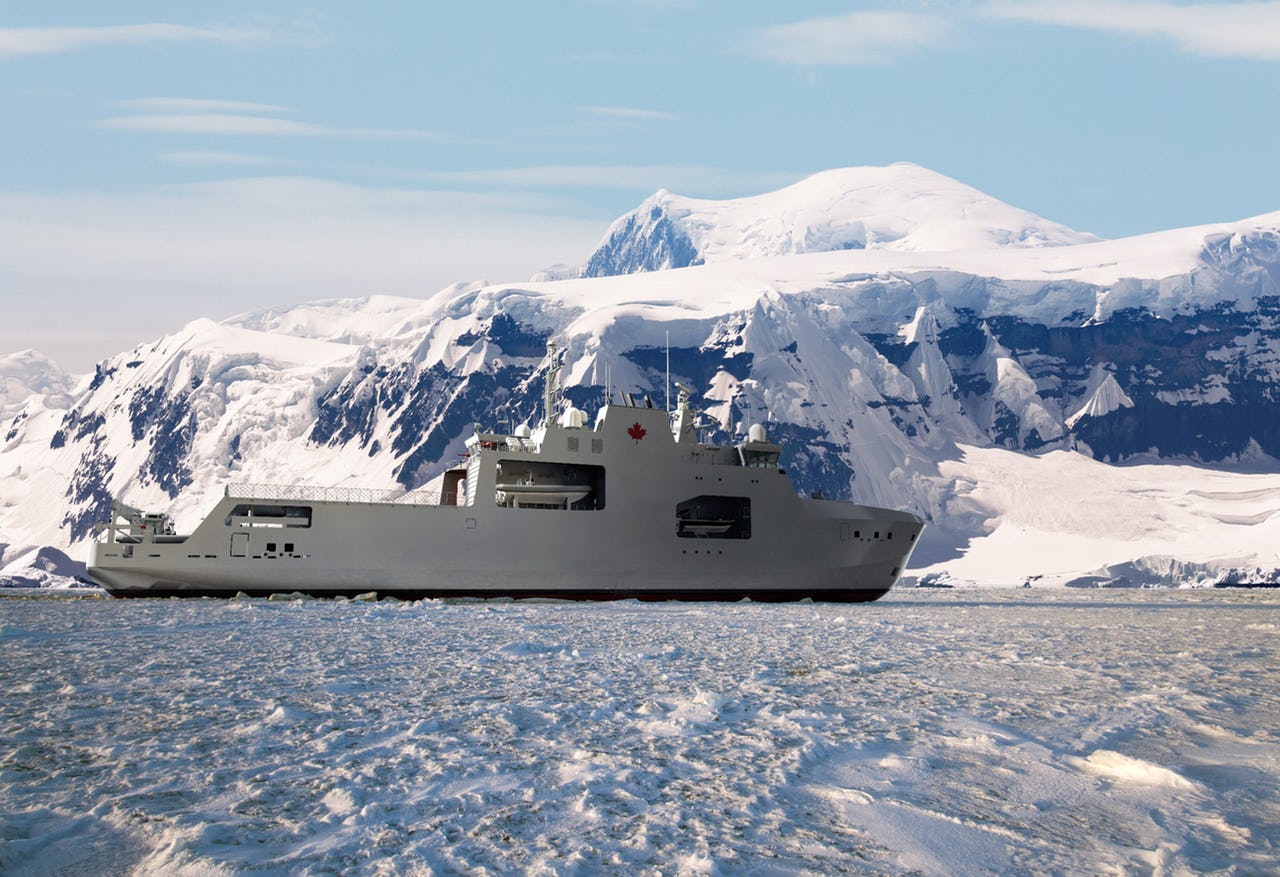An Arctic Council Security Agreement (Part I)

Artist’s impression of the Harry Dewolf-Class Arctic and Offshore Patrol Vessel. Photo: Irving Shipbuilding Inc.
Imagine in 2040 the Arctic Ocean is navigable for an extended period each summer. Then imagine Arctic states navies going to war, head to head, in the Arctic Ocean over natural resources. A computer game set to be released in the second quarters of 2012 called Naval War: Arctic Circle, imagines just such an environment. According to CPU Gamer, “In the future, civilization is still reliant on petroleum, but the easily accessible land-based oil reserves are dwindling rapidly. The nations of the far north struggle to harness the rich untapped wells of the Arctic Circle and will go to war to guarantee control of the black gold.”1) The irony of the scenario Naval War: Arctic Circle projects is exactly why an international mechanism is needed to preclude such a scenario.
So it isn’t to hard to imagine an Arctic where every Arctic nation has its own fleet of armed Arctic patrol ships like the one pictured above. What would that kind of Arctic be like? Would it constitute a militarization of the Arctic? Would such a development encourage conflict? The more important question is how can Arctic states undertake Arctic Patrol Ship construction programs without jeopardizing the stability of the Arctic? The answer is to commit to an Arctic Council Security Agreement centered around the creation of a multi-national Arctic Response Force that recognizes and respects states, and their indigenous populations sovereignty.
Arctic states are actively undertaking major Arctic shipbuilding programs. The latest pronouncement came from the Russian Federation, who on 20 December 2011 announced the Zvezdochka yard in Severodvinsk will begin construction of ice-class vessels crewed by a complement of sixty and designed to transport military hardware.2) By the same token, on 19 October 2011 Canada’s National Shipbuilding Procurement Strategy (NSPS) Secretariat announced Irving Shipbuilding, Inc. had been selected to build the Arctic Offshore Patrol Ship.3) Norway and Denmark currently possess armed Arctic patrol ships. The Norwegian Svalbard class and the Danish Thetis-class ice- capable patrol ships current operate in Arctic waters.4) Despite the projected proliferation of ice-capable Arctic patrol ships, this does not currently constitutes a threat to Arctic security.
To avoid jeopardizing the current stability of the Arctic, brokering an Arctic Council Security Agreement is perhaps the best way to avoid militarization of the Arctic in the longer-term. Long-term stability in a region could be jeopardized by misunderstandings and further exacerbated by a general lack of a shared vision. The Arctic region comprised of five littoral states, eight Arctic Council member states and several indigenous nations all have a vested interest in a stable Arctic today for economic and security reasons. However, a regional security agreement should be put in place as the Arctic opens to increased exploitation to guarantee stability and security. Without one, events are left to chance and chance is a fickle partner.
But under which international body should a regional security agreement be brokered? Preliminarily, there are significant obstacles to creating an Arctic Council agreement because the council’s charter precludes it from dealing with matter related to military security.5) But the obstacles associated with an Arctic Council Security Agreement aside, let’s consider possible options. Possible candidates include the North Atlantic Treaty Organization (NATO), the European Union (EU), the United Nations (UN), the Arctic Council (AC) and perhaps an ad hoc organization. The North Atlantic Treaty Organization cannot be considered a likely candidate because some of the Arctic Council nations are not member states and Russia would interpret the Alliance’s presence in the Arctic as tantamount to encirclement. The EU is not a likely candidate because not all Arctic Council nations are part of the EU and some of these countries overtures to join the EU have been spurned. The UN could be likely a candidate, however, were the United States inclined to join, Congress would likely interpret participation under the UN as an encroachment on its sovereignty. One has only to look at opposition within the U.S. Senate to accession to the Law of the Sea Treaty to understand the challenge associated with this option. That leaves either the Arctic Council or an ad hoc organization.
One way of looking at these options is to ask oneself which organization represents the best guarantor of Arctic nation’s, and their indigenous population’s, security? Success being defined as all Arctic nations agree to collectivized security and the Arctic opens in a peaceful manner consistent with international norms.
In short, the logical answer is a fundamental change to the Arctic Council’s charter. Caution is strongly recommended when amending international treaties or agreements. That is why this author recommends a more nuanced approach. The question then is what kind of challenges would encourage Arctic littoral nations to collectivize security? The immediate challenge facing Arctic nations and their indigenous populations are safety and security related. The recent Arctic Council Search & Rescue Agreement highlights a principle concern of its member states. Discussions about environmental response and fisheries protection are further examples of contemporary safety and security needs. And these challenges will mainly come on the periphery, along the Northern Sea Route and the Northwest Passage for the immediate future. But, if the satellite record data continues to reveal a receding ice cap, one can only assume that in twenty years time much more of the Arctic Ocean will be navigable. Therefore, it is vital to plan today for tomorrow’s safety and security challenges.
See also Part II: An Arctic Council Security Agreement: Preventing Militarization and Ensuring Stability and Security of the Arctic
References